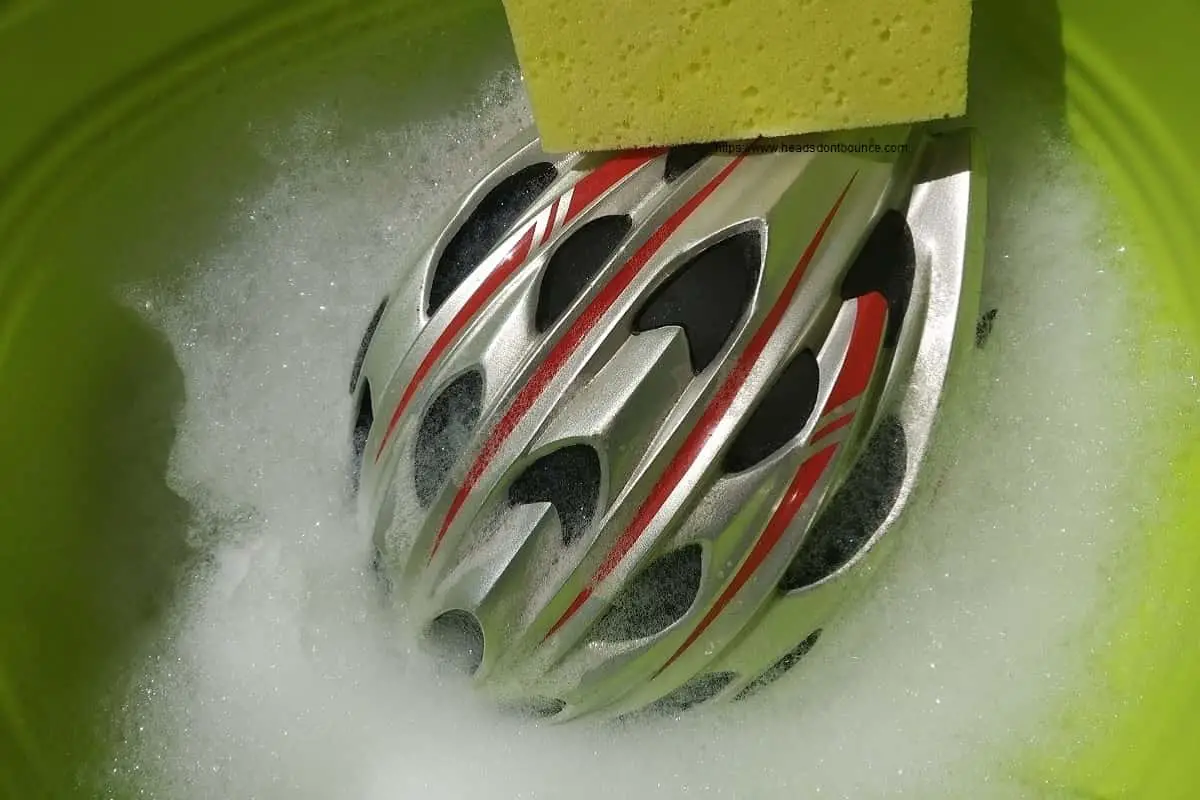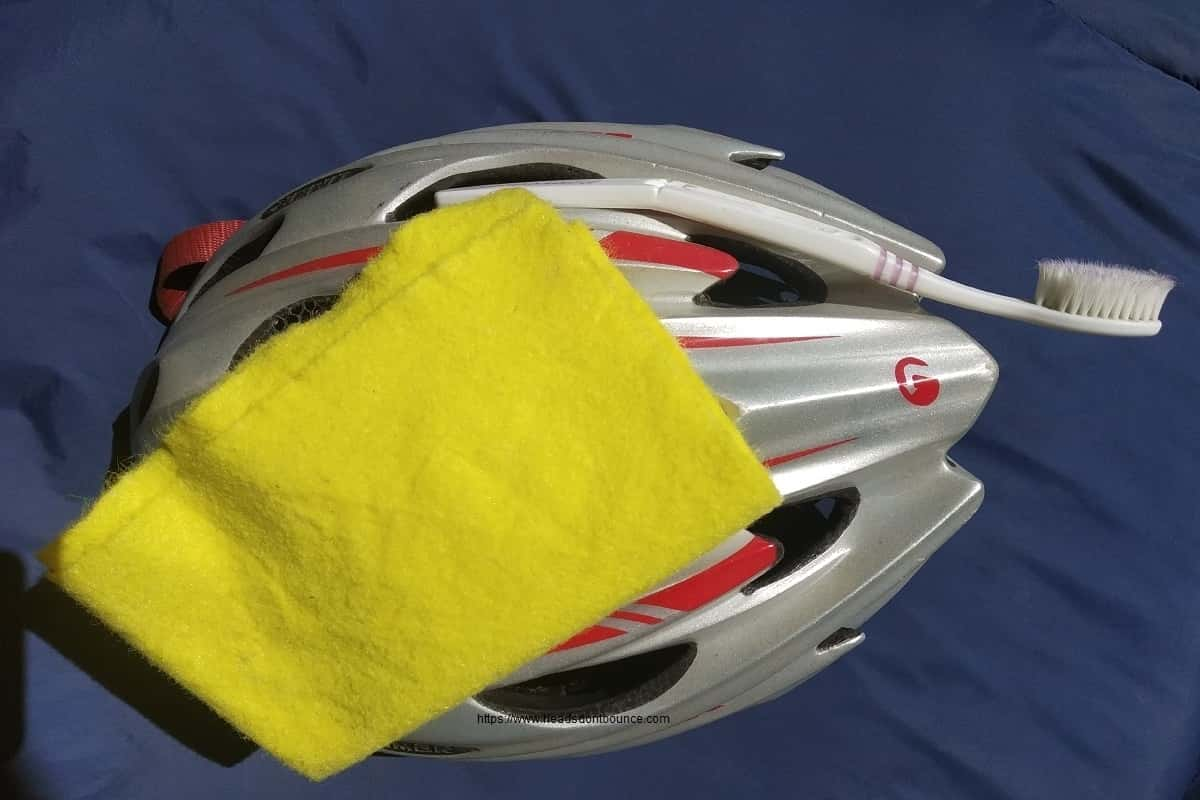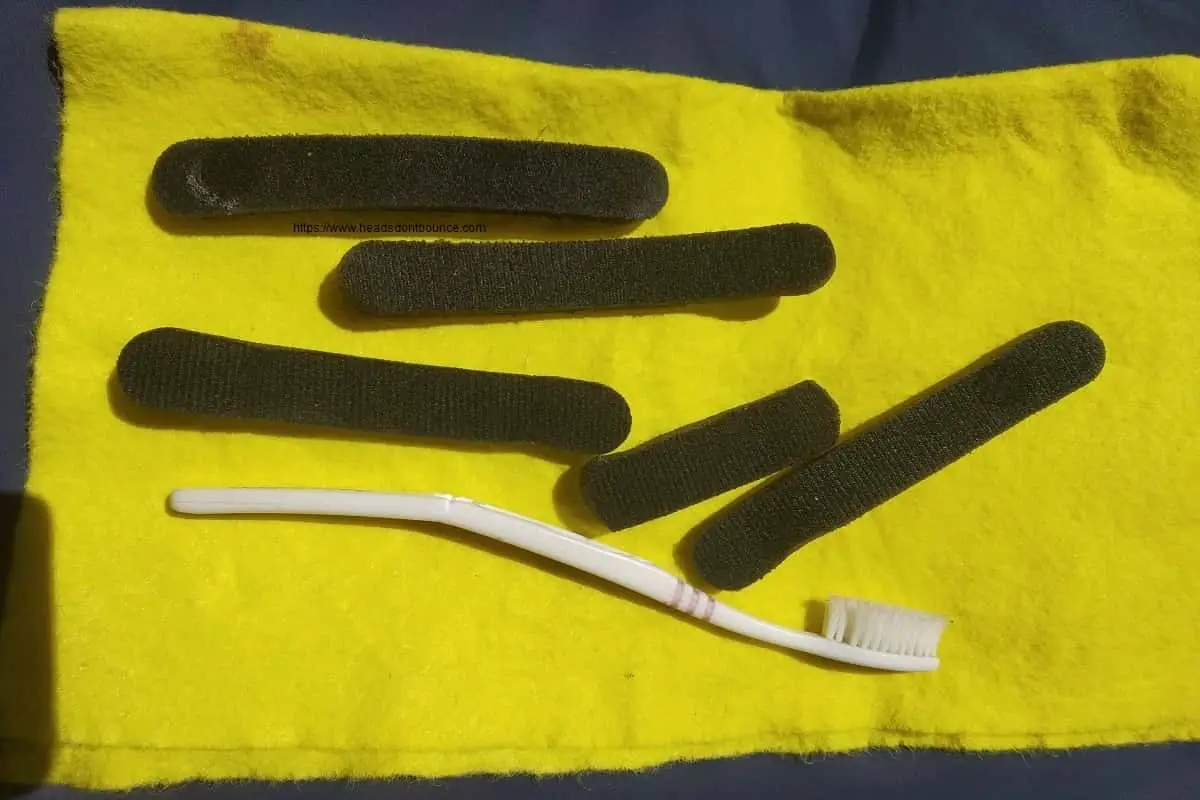How to Wash a Bike Helmet
Do you recall the last time you gave your bike helmet a good clean? And I don’t mean just wiping down the exterior.
Every time you ride, your helmet’s outer shell is exposed to mud, dirt, dust, and insects. Meanwhile, your helmet’s interior absorbs all the sweat from your scalp, and oil from your hair.
Cleaning your bike helmet is an important part of helmet care. In this guide, we’ll provide tips on how to wash a bike helmet.
Knowing how to wash a bike helmet is a simple way to extend the lifespan of your helmet.
KEY TAKEAWAYS
* Don’t be afaid to submerge your helmet completely under the water.
* Use warm water, not hot water.
* Use a mild soap or baby shampoo.
* Use a toothbrush to clean the vents and other fiddly bits.
* Yes, you can shower with your helmet on.

Disclosure: As an Avantlink and Amazon Associate, we earn from qualifying purchases. Disclosure Statement.
Page Content
How to Wash a Bike Helmet
If you keep your helmet clean, you can be more confident that it could last for a long time and do its primary job of protecting your head and brain from injury.
Bike helmet cleaning might seem tedious to do, but it needn’t be. To give your helmet a thorough cleaning, you may have to remove some parts to ensure you get every bit of dirt off.
Before you detach the components of your bike helmet, read the manufacturer’s instructions on how to remove parts properly. Also, take note of which part goes where so you won’t have any trouble putting everything back after cleaning and drying the helmet.
How to Clean Bike Helmet Shell
Cleaning a bike helmet shell may seem the easiest part of the wash. However, it doesn’t mean you should put in less care when cleaning it. Here are some tips on how to clean bike helmet shell before you get started:
- Remove accessories or external devices like LED lights, Bluetooth speakers (available from Amazon), or camera mount
- You can use mild soap or baby shampoo (available from Amazon) for washing your bike helmet
- If the dirt in the vent channels is hard to remove with a toothbrush, you can use an air compressor to blow out the obstructions
- After you finish, you can apply an automotive wax coat (available from Amazon) as a protective layer and to make future washes easier
- If your helmet has a glossy shell, you may use a detailing spray to add shine
If your bike helmet is caked with mud, grime, or dust, you must first prep it before proceeding to clean it. A quick way to loosen caked-on dirt is by immersing your helmet under water with the crown down, and leave it to soak for 5 to 10 minutes.

If you’re worried about fully immersing your bike helmet, don’t be. Submerging the helmet is part of the bicycle helmet certification process. If your bike helmet is properly certified, there should be no negative effects if you submerge it in water during bike helmet cleaning.
Just remember to use warm water and not hot water. Using hot water might react with the adhesive that attaches the inner liner to the outer shell of the bike helmet.
RECOMMENDED: Best Affordable MIPS Bike Helmets
If your helmet isn’t excessively dirty, you don’t necessarily need to soak the helmet, but instead soak a microfiber cloth in warm water then put it over the helmet for a few minutes. Doing so softens any dirt, making it easier to clean without scratching the helmet shell.
This content was originally published on headsdontbounce.com. If it appears on another website, it is a violation of the copyright owned by headsdontbounce.com.
You can either use a moist microfiber cloth or soft sponge to clean the outside of your helmet. Wipe the inside of the vents and the edges of the helmet. For hard-to-reach areas, you can use Q-Tips or a toothbrush with soft bristles to get rid of dirt.
If your bike helmet comes with a visor, remove the visor, soak it in lukewarm, soapy water, then clean it with your cloth. Let the visor air-dry before polishing it with a microfiber cloth.
How to Clean Bike Helmet Foam Liner
The inner part of your bike helmet is lined with EPS foam. This part doesn’t usually come into direct contact with your head so it gets less exposed to sweat or your hair, more so if you wear a bandana, doo-rag, or bonnet over your head. But when the EPS foam liner gets dirty, it is essential to clean it as carefully as you can so as not to damage it.
Before washing the bike helmet foam liner, fill a tub or bucket with water. Alternatively, you can use your kitchen sink. Then add a liquid soap. Using baby shampoo is recommended because it has a gentle formula and it won’t leave the lining crusty after it dries.
To wash the bike helmet foam liner, soak your bike helmet or dunk it a few times in the soapy water. Gently rub the liner with your fingertips to wipe away any dirt and grime. You can also use a wet sponge or microfiber cloth to wipe dirt and grime off the liner. After washing, rinse the liner with clean water to remove excess soap or shampoo.
Set aside your bike helmet and let the liner air-dry. You can also blot the liner with a towel to absorb excess water, then use a non-heated fan to blow air on the foam liner.
Below are some additional tips on how to clean bike helmet foam liner:
- Never use cleaning products with harsh chemicals like bleach or ammonia
- Don’t put your bike helmet in the dryer to avoid damaging the foam liner
- Store your bike helmet only when it is completely dry
How to Clean Bike Helmet Pads
You can clean bike helmet pads either by hand-washing them in a tub, basin, or sink with soapy water or in a washing machine with a mixture of water and mild laundry detergent.

To ensure the pads remain in good shape after washing, take note of these tips on how to clean bike helmet pads.
- Let the helmet pads (and cheek pads if your bike helmet has them) sit in the solution for a few minutes before washing them
- Massage and squeeze gently to prevent them from bunching up
- Try using an anti-microbial detergent to get rid of funky odor
- Rinse thoroughly with clean water to remove soap residue
- Hang to dry or use an electric fan. Never apply heat, like that coming from a hairdryer, to make the drying process quicker
If your helmet padding is looking worse for wear, you might want to consider replacing the padding. There are replacement pads available for most helmet brands on Amazon.
How to Clean Bike Helmet Straps
Bike helmet straps, like helmet padding, easily absorbs sweat, dead skin, and body oils. If not cleaned properly, bacteria can grow and make the helmet straps stinky. Besides giving off an unpleasant odor, the germs and bacteria in dirty helmet straps could potentially cause skin irritation.
If you want to wash bike helmet straps properly, remove the inner liners and padding of the helmet first. While the straps are still dry, using a cotton swab or a toothbrush, gently brush salt deposits, dirt, hair strands, or dead insects from the straps. Bending the straps can help reach gaps and remove dirt inside them. Be careful not to brush too hard to avoid damaging the material.
After dry brushing the straps, soak them in soapy water for a few minutes to loosen any remaining dirt. You can also place the straps under a gentle stream of water to dampen them. Then, put mild soap on the wet helmet straps. Rub or brush the straps gently to clean the straps.
Once you’re done brushing, put the straps under flowing water to rinse them thoroughly. After rinsing, let the bike helmet straps dry in the open air. Once the helmet straps are completely dry, check if they still smell unpleasant. If they do, repeat the entire process.
As a bonus, here are more pro tips on how to clean bike helmet straps.
- Don’t use petroleum-based products. Instead, use water-based cleaners or mild shampoo
- You can soak the bike helmet straps in a mixture of water and vinegar (1:10 ratio) before washing them with soap and water
- Avoid squeezing or twisting the straps, as doing so may cause damage to the material
How to Deodorize a Helmet
If your bike helmet still smells funky even after washing it, you can try using a bike helmet cleaner as an alternative to soap and water.
Some bike helmet cleaners come in a spray container, which means you can spray them on the exterior and interior of your helmet and wait for it to dry, and then you gently wipe them off with a soft, clean microfiber cloth. Many bike helmet cleaners come with antibacterial ingredients for disinfecting and deodorizing your bike helmet.
For on-the-go cleaning, you can use a bike helmet deodorizing spray. Deodorizing sprays work fast at getting rid of helmet odor. However, take note that they have a temporary effect and you still need to give your helmet a thorough wash.
Final Tip: If you’ve done all of the above and your helmet still smells bad, buy a new helmet, or try this. Get some Baking Soda (Sodium bicarbonate a.k.a bicarbonate of soda) and sprinkle it liberally around the inside of the helmet and leave it for as long as possible, say 24 hours. You can then shake it out, and wipe the interior or use a vacuum cleaner and a cloth.
Frequently Asked Questions
Q. Can I wash my bike helmet while taking a shower?
A. Many cyclists shower with their helmets on because it is one of the quickest ways to wash a bike helmet. As mentioned above, water-based shampoos or shower gels may be used in bike helmet cleaning. However, use a sponge or microfiber cloth to wash your bike helmet thoroughly.
Q. Can I clean my bike helmet in a dishwasher?
A. It is not recommended to use a dishwasher, washing machine, microwave, or hairdryer in cleaning bike helmets. The heat from these household appliances could damage the outer shell. It can also destroy the material of the helmet components. When this happens, your bike helmet could lose its protective capacity.
Related Reads:


